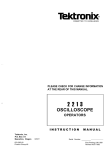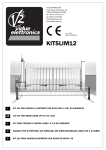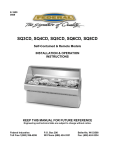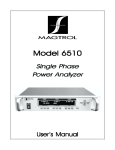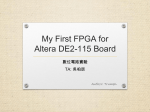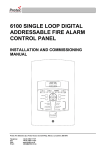Download Wavetek 132 Specifications
Transcript
MODEL 132 VCG/NOISE GENERATOR @ - 1981 - Wavetek THIS DOCUMENT CONTAINS INFORMATION PROPRIETARY TO WAVETEK AND IS SOLELY FOR INSTRUMENT OPERATION AND MAINTENANCE. THE INFORMATION IN THIS DOCUMENT MAY NOT BE DUPLICATED IN ANY MANNER WITHOUT THE PRIOR APPROVAL IN WRITING OF WAVETEK. SAN DIEGO 9045 Balboa Ave., San Diego, CA 92123 P. 0 Box 651, San Diego, Calif. 92112 Tel 7141279-2200 TWX 91 O-335-2007 Manual Revision: 10181 Instrument Release: U-l 0180 CONTENTS Section One SPECIFICATIONS Physical Section Two and Electrical Specifications . . . . . . . . . . . . . . OPERATION ...................... Inspection Operating Controls .................... ...................... Operation Section Three Description . . . . . . . . . . . . . . . . . . . . 11 MAINTENANCE Introduction ...................... Recommended Test Equipment ................ Checkout and Calibration .................. Troubleshooting ..................... Section Five 3 4 7 CIRCUIT DESCRIPTION General Section Four 1 13 13 13 16 DATA PACKAGE Introduction ...................... ................ Recommended Spare Parts List 21 21 SCOPE OF MANUAL SCOPE OF EQUIPMENT This manual contains instructions for operating, testing, and maintaining the Wavetek Model 132 VCG/ Noise Generator. The Wavetek product-improvement program ensures that the latest electronic developments are incorporated into the Wavetek instruments by the addition of circuit and component changes as rapidly as development and testing permit. Due to the time required to document and print this manual, it is not always possible to incorporate these changes into the manual. In this case, data will be found on engineering change sheets at the back of the manual. If there are no change sheets, the manual is correct as printed. The Model 132 is a source of analog and digital noise, as well as a precision source of sine, triangle and square waveforms. Noise outputs, or waveforms can be used individually, or combined to provide selectable, calibrated signal-to-noise and noise-to-signal ratios to +60 dB. Waveforms can be varied over a frequency range of 0.2 Hz to 2 MHz. Length of the digital sequence is selectable to a maximum of 220 - 1 bits. Clock rates, variable from 160 Hz through 1.6 MHz, give added versatility to the noise generator. These clock rates allow selectable noise bandwidths variable from 10 Hz to 100 kHz. SAFETY r via the facil ty i powe rwiring. Do not Thi s instrument i wire s dfor earth g ounding ith two wir extension e cords, plug adapter setc. bYPa ss earth grou dingn w BEFORE PLUGGING IN the instrument, comply with installation instructions. t sremoved. MAINT ENANCE may requir power e on w thi th einstrumen cover l e of the elect rica hl azards. shoul dbe don eonly by qualified personne awar WARNING notes call attention t operations. possibleo injury or death hazards i subsequentn CAUTION notes call attention to possible equipment damage in subsequent operations. 1 SECTIO N SPECIFICATIONS VERSATILITY HORIZONTAL PRECISION Waveforms Sine YJ , square I-I , triangle 2/ waveforms and analog noise M.r , or digital noise l-u--L Dial Accuracy *2% of full scale, 1 Hz to 2 MHz Frequency Range of Signal 0.2 Hz to 2 MHz in 6 decade ranges Frequency Vernier One turn equals 1% of full scale. Ranges x 10 X l 00 X1K X10K XIOOK X1M 0.2 Hz to 20 Hz 2 Hz to 200 Hz 20 Hz to 2 kHz 200 Hz to 20 kHz 2 kHz to 200 kHz 20 kHz to 2 MHz Function Outputs Sine \ , square f-l~ , and triangle 2/ selectable, with 60 d B step attenuator in 10 d B steps and overlapping calibrated vernier; 5Oa output impedance, 20 V p-p into open circuit and 10 V p-p into 5Oa load from 5Oa source impedance. Sync Output Greater than 1 V p-p square wave into open circuit at 6OOa output impedance. DC Offset *5 V offset (22.5 V offset into 5Ofi load) controlled from rear panel; peak amplitude limited by the dynamic range of the amplifier output. VCG - Voltage Controlled Generator Frequency of the generator may be dc-programmed, or ac-modulated by external 0 to *5 V signal. Voltage control circuitry is capable of 1000: 1 deviation. The VCG amplifier has a 100 k H z bandwidth and a slew rate of 0.1 V&s. The instantaneous frequency is the result of the sum of the dial setting and the externally applied voltage. Stability +0.05% for 10 minutes Short term +0.25% for 24 hours Long term Percentages apply to amplitude, frequency, and dc offset. Time Symmetry *I % through XIOOK range VERTICAL PRECISION Sine Wave Frequency Response Amplitude change with frequency less than: 0.1 d B from 0.2 Hz to 200 k H z 0.5 d B from 0.2 Hz to 2 MHz PURITY Sine Wave Distortion Less than: 0.5% on X10, X100, X1K,X 1 0 K ranges 1.0% on XIOOK range All harmonics 30 d B down on Xl MHz range Square Wave Rise and Fall Time Less than 50 ns terminated into SOQ NOISE outputs Pseudo-random analog or digital noise h wit a maximum of 20 V p-p excursion (open circuit) with 60 d B step attenuator in 10 dB steps and overlapping calibrated vernier. Sequence Lengths Push buttons on the front panel provide a sequence length of 21° - 1, 215 - 1, or 220 - 1. 1 Noise Cl o c k Frequency Switch selectable noise frequencies are listed Analog Noise Bandwidth Clock Frequency 10 Hz 100 Hz 1 kHz 10 kHz 100 kHz 160 Hz 1.6 kHz 16 kHz 160 kHz 1.6 MHz OPERATIONAL MODES FUNC Function Mode - Provides the selected form at the main output. S/N Signal-to-Noise operation adds noise to a selected signal of constant amplitude. The signal-to-noise ratio is variable from 0 to +60 dB. N/S Noise-to-Signal operation adds a selected signal to a constant amplitude noise. The noise-to-signal ratio is variable from 0 to +60 dB. FM Frequency Modulation - Provides random modulation of the frequency of the generator. The S/N - N/S (dB) ratio control also controls the amount of frequency deviation. NOTE When noise is added to the signal output, specifications apply up to 200 kHz and the square wave rise time is dera ted by a factor of 10. In the clock range of 1.6 MHz, the maximum calibrated signalto-noise ratio is 30 d B ENVIRONMENTAL Temperature All specifications listed, except stability, are for 25’C *5’C. For operation from O°C to 55’C, derate all specifications by factor of 2. MECHANICAL Dimensions 8% inches wide, 5% inches high, 11% inches deep Weight 8 Ibs net, 12 Ibs shipping Power 105 V to 125 V or 200 V to 250 V, 50 Hz to 400 Hz. Less than 15 watts. NOTE All specifications apply for frequencies obtained when dial is between 0. 1 and 2.0 and at 10 V p-p in to a 50 ohm load. It is possible to stop the generator from oscillating by applying a negative VCG voltage when the dial is already set at minimum frequency. VCG inputs up to 30 V will not permanently damage the ins trumen t. SECTION l OPERATION 2. 3. INSPECTION The following procedures should be performed to assure the user that the instrument has arrived at its destination in satisfactory operating condition. Complete calibration and checkout instructions are provided in Section 4 to determine compliance with electrical specifications. 4. 5. 6. Checking Visually 7. After carefully unpacking the instrument, visually inspect the external parts for damage to knobs, dials, indicators, surface areas, etc. If damage is discovered, file a claim with the carrier who transported the instrument. Retain the shipping container and packing material for use in case reshipment is required. 8. 9. 10. Checking Electrically 11. NOTE lnstrumen ts are normally shipped connected for 115 V power unless 230 V power is ordered. Refer to the end of this section for conversion instructions. The steps in this paragraph provide a quick checkout of the instrument operation. If electrical deficiencies exist, refer to the WARRANTY in the front of this manual. The following test equipment is recommended for performing this electrical inspection: Name Required Characteristics 12. 13. 14. 15. 16. Oscilloscope Plug-l n Plug-l n Counter-Timer To 30 MHz Dual channel Peak mV measuring capability To 2 MHz with 5-digit resolution 17. 18. 19. 1. Turn FREQ HZ selector to the Xl K position. (This connects ac power to the unit and establishes the frequency multiplier.) Depress MODE - FUNC push button. Connect oscilloscope to the 5Ofi OUT connector with a 5Oa terminator. Set frequency dial to the 1.0 mark and FREQ VERNIER to CAL position. Set function selector to the yj position. Set OUTPUT ATTEN (dB) and OUTPUT VERNIER (dB) to maximum clockwise (cw) position (no attenuation). Check for 1 kHz sine wave with at least 10 V p-p amplitude on oscilloscope. Select 2/ and s with function selector and check for 10 V p-p amplitude on oscilloscope. Turn frequency dial from maximum counterclockwise (ccw) to maximum cw position and check for frequency change. Step OUTPUT ATTEN (dB) selector through its range and verify attenuation at each step. Rotate OUTPUT VERNIER (dB) control from maximum cw to maximum ccw position and check for decreasing amplitude. Rotate FREQ VERNIER control and check for frequency change. Set FREQ VERNIER control at maximum cw and frequency dial at 0.02. Set frequency to 20 Hz with counter. Connect a 0 to +5 Vdc input to the VCG IN connector. Slowly increase voltage input from 0 to +5 V and check that frequency of output waveform increases from approximately 20 Hz to 2 kHz. Depress SEQUENCE LENGTH 2l* - 1 push button. Set NOISE FREQ HZ selector to the 16K/160K position and vernier control fully cw. Connect a BNC cable from the NOISE SYNC connector (rear panel) to the external trigger input of the oscilloscope. Rotate the function selector to m and check to assure oscilloscope displays digital noise. Check to assure SEQUENCE LENGTH push buttons vary the bits in the sequence length. Step NOISE FREQ HZ selector through its range and check to assure clock frequency changes. (Use NOISE CLOCK connector on rear panel.) 3 20. 21. 22. 23. 24. 25. 26. 27. 28. Depress MODE - N/S push button and rotate S/N - N/S (dB) selector ccw through each position, checking for reduction in signal level. Verify that the S/N - N/S (dB) vernier attenuates the signal approximately 10 dB between each step of the S/N - N/S (dB) selector. OPERATING CONTROLS The operating controls and electrical connections for the Model 132 are shown in Figures 2-I and 2-2. Each of the following paragraph numbers corresponds to a number appearing in Figure 2-1, front panel, or Figure 2-2, rear panel. The listing below discusses each control and its function. FRONT PANEL 1. 2. 4 of full scale. When turned to the full cw position (CAL), settings on the main dial will be calibrated. Verify that NOISE FREQ HZ vernier control provides approximately IO: 1 variation in clock frequency at the NOISE CLOCK connector (rear panel). Rotate function selector to /‘=ltif’ position and check to assure oscilloscope displays analog noise. Check to assure SEQUENCE LENGTH push buttons vary the length of the sequence of analog noise. (Use NOISE SYNC connector on rear panel.) Connect oscilloscope external trigger cable to FUNCTION SYNC connector (rear panel) and set function selector to I -I _I position. Set S/N - N/S (dB) selector to -10 position and vernier control fully ccw. Depress MODE - FM push button and check to assure square waveforms are frequency modulated by analog noise. Release MODE - FM push button and depress MODE - S/N push button. Check to assure square wave and analog noise are mixed. FREQ HZ/PWR OFF - Selects one of six decade ranges from X 10 to X1M for generator frequency. This value multiplied by the frequency dial setting (3) gives the output frequency of the generator. Extreme ccw rotation will place the switch in the PWR OFF position, turning off all power to the function and noise generators. This control has no affect on the noise frequency. FREQ VERNIER - Allows precision electronic control of the signal output frequency. A full turn of the control is approximately equal to 1% Frequency Dial - Allows coarse control of the signal output frequency. Frequency Index - Indicates the frequency dial setting (3) by reading the dial position opposite the scribe line on the frequency index. The index is illuminated when power to the unit is on. Function Selector - Selects the desired function or noise output. To select ‘1, , i*\./ , or I, waveforms, or J/-IL_ or /‘-‘iv‘ noise, the FUNC push button (7) must be depressed. OUTPUT VERNIER (dB) - Provides vernier control of 0 through -20 dB from the OUTPUT ATTEN (dB) setting (12). This is the fine adjustment for the output signal and will attenuate signal and noise. MODE FUNC - When depressed, this control allows the selected waveform or noise, as determined by the position of the function selector (5), to be present at the 5Oa OUT connector (11). This push button must also be in the depressed position for the frequency modulation mode (10). S/N - Depressing this push button allows a calibrated amount of analog noise to be added to the selected signal, either 2/ wave. The signal-to-noise ratio (S/N) is determined by the S/N - N/S (dB) attenuator control (13). When in this mode, the peak to peak signal amplitude is reduced internally, since adding noise to the signal would overdrive the output amplifier. r , 2/ , or N/S - Depressing this push button allows a calibrated amount of the selected signal, either i L Ad , or ‘ L wave, to be added to the analog noise. The noise-to-signal ratio (N/S) is determined by the S/N - N/S (dB) attenuator control (13). When in this mode, the peak to peak signal amplitude is reduced internally, since adding the signal to the noise would overdrive the output amplifier. , 7 I WAVETEK ,, VCG!NQISE MO~EI.. 132 GENERATOR Figure 2-l. Operating Controls, Front Panel 10. 11. 12. FM - Depressing this push button along with the FUNC push button (7) allows the selected or z wave, to be signal, either /‘\u , vA , pseudo-randomly frequency modulated, or jittered. The modulating signal is provided by pseudo-random analog noise, and the S/N N/S (dB) controls frequency deviation. The bandwidth of the modulating signal is controlled by the NOISE FREQ HZ selector (15) and vernier (16). 5Oa OUT - Provides the selected generator output function. The generator may operate into an open circuit providing 20 V peak to peak maximum, or into a 5Oa load providing a 10 V peak to peak output. OUTPUT ATTEN (dB) - Attenuates the output (both signal and noise) from 0 dB to -60 dB in six calibrated 10 dB steps according to the following table: Step Attenuator Position 0 -10 -20 -30 -40 -50 -60 * 13. dB dB dB dB dB dB dB Output peak to peak into 5Ofl Load Maximum Vernier fully cw 10V 3 V I V 0.3 v 0.1 v 0.03 v 0.01 v Minimum Vernier* I 0.3 0.1 0.03 0.01 0.003 0.001 V v v v v v v The values in this table are approximate. The OUTPUT VERNIER (dB) (6) will reduce the output approximately 20 dB in all cases, as shown. S/N - N/S (dB) - I n the S/N mode, this control attenuatesthe analog noise from 0 to -50 dB in five calibrated 10 dB steps. The selectable signal 5 amplitude remains constant, thus giving calibrated 0 to -50 d B signal-to-noise ratios. In the N/S mode, the signal is attenuated with the noise remaining unchanged, thus giving noiseto-signal ratios from 0 to -50 dB. The steps for this control are indicated in black numerals on the front panel. 14. 15. 16. 17. S/N - N/S (dB) Vernier - Allows a calibrated fine adjustment of the S/N - N/S (dB) step attenuator (13). This control is continuously variable over at least a 10 dB range. When added to the coarse control (13), this amount equals the total S/N or N/S ratio. Approximate values of attenuation are indicated in red numerals on the front panel. NOISE FREQ HZ - This range control selects the clock frequency, or bandwidth for the digital, or analog noise, respectively. When using the digital noise function, clock frequencies from 160 Hz through 1.6 MHz (indicated in black numerals and letters on the front panel) are available. When using analog noise or the S/N, N/S modes, the bandwidth of the analog noise may be selected from 10 Hz to 100 kHz (indicated in red numerals and letters on the front panel). In the FM mode, this control establishes the bandwidth of the analog noise used for frequency modulation. There are four detent positions with an overlapping vernier control (16). With the vernier in the full cw position, the clock frequency, or bandwidth, is equal to the value printed to the right of the detent mark. NOISE FREQ HZ Vernier - As mentioned in number 15, this control provides a continuous, fine control between the detent positions of thecoarse control. When in the full cw position, the clock frequency, or bandwidth, is equal to the value appearing at the right of the detent mark. As the knob is rotated ccw, the clock frequency, or bandwidth, is decreased. In the full ccw position, the actual value will be at least 10: 1 (and as much as 100: 1) lower than the value to the right of the detent mark. VCG IN - This connector allows external voltage control of function generator frequency. Up to 1000:1 frequency change may be obtained. A positive voltage increases frequency and a negative voltage decreases frequency. Refer to “Operation as a Voltage Controlled Generator.” SEQUENCE LENGTH 21° 18. - 1 - Depressing this push button will provide 1,023 counts of the selected clock frequency, or bandwidth, determined by the N O I S E FREQ HZ controls (15 and 16), for generation of a digital, or analog noise pattern. At the end of each sequence, the pattern is automatically repeated. 19. 215 - 1 - Depressing this push button will provide 32,767 counts of the selected clock frequency, or bandwidth, determined by the N O I S E FREQ HZ controls (15 and 16), for generation of a digital, or analog noise pattern. At the end of each sequence, the pattern is automatically repeated. 20. 220 - 1 - Depressing this push button will provide 1,048,575 counts of the selected clock frequency, or bandwidth, determined by the NOISE FREQ HZ controls (15 and 16), for generation of a digital, or analog noise pattern. At the end of each sequence, the pattern is automatically repeated. REAR PANEL 21. DC OFFSET - This control adjusts the *5 V base line above or below ground (k2.5 V offset into 5Oa load). The OFF position gives normal vertical symmetry. Peak amplitude is limited by the dynamic range of the amplifier output. 22. FUNCTION SYNC - This connector provides a synchronizing signal output at the same frequency of the main generator; that is, at the same frequency as the sine, triangle or square wave. The amplitude is greater than 1 V peak to peak square wave into open circuit at 6OOa output impedance. 23. NOISE SYNC - This connector provides a synchronizing output signal for monitoring the digital or analog noise. A sync signal is generated at the beginning of each repetitive cycle for the selected sequence length of digital or analog noise. 24. NOISE CLOCK - This connector provides an external output of the basic clock frequency used to generate the digital sequence and analog noise. _ SAN OILGQ l CALfFORNfA PAT. NO X268.738 OTHER PAT PEND. MAN fp1 tt.S,A. 115 VAC 114 AMP 23OVAC 7htAMP Figure 2-2. Operating Controls, Rear Panel OPERATION Operation as a Voltage Controiled Generator No preparation for operation is required beyond completion of the initial installation previously stated in this section. It is recommended that a one-half hour warm-up period be allowed for the associated equipment to reach a stabilized operating temperature and for the Model 132 to attain stated accuracies. The VCG input connector can be used to externally control the frequency of the generator. If a positive voltage is applied to the VCG input terminal, the frequency will increase from the dial setting, A negative voltage will cause the frequency to decrease from the dial setting. The VCG range of the Model 132 is 1000:1. Operation as a Function Generator 1. 1. 2. Terminate 5Oa OUT connector with 5Oa *I%, 2 watt termination. Select the desired waveform by setting function selector to \ , 2/ , or ?_1 , Set frequency dial and FREQ HZ range multiplier for desired output frequency. Depress MODE - FUNC push button. Select output signal amplitude by setting OUTPUT ATTEN (dB) control to appropriate attenuation position and fine adjusting signal to desired amplitude with OUTPUT VERNIER (dB) control. A positive or negative dc offset may be applied to the waveform by setting the DC OFFSET (Rear Panel) to the desired level. The peak signal value plus the offset cannot exceed k5.0 V into 50 ohms. 2. 3. 4. Terminate 5Oct OUT connector with 50 ohm +l%, 2 watt termination. Select the desired waveform by setting function selector to $ , /YJ , or ‘1~ . Set FREQ HZ selector to desired multiplier. Connect external voltage source (dc programming or wideband ac signal) to VCG IN connector. NOTE VCG input requires 0 to % volts for operation over full-scale range, but can withstand many times maximum input. 5. Set frequency dial as follows: a. For frequency modulation with ac input, set dial for center frequency. 7 6. b. For increasing frequency sweep with positive dc input, set dial to lower frequency limit. c. For decreasing frequency sweep with negative dc input, set dial to upper frequency limit. To sweep the audio range from 20 Hz to 20 kHz, set the controls to 20 Hz as follows: a. Set the main dial to 0.02. b. Set the frequency vernier to the full ccw position. c. Introduce a 0 to +5 V ramp into the VCG inputconnector. In example 1, the dial is set at 1.0 and 0 voltage is applied to the VCG input. Extend a straight line from 1.0 (dial setting) through 0 voltage (VCG voltage) and obtain a dial frequency of 1.0. For the total output frequency, multiply the range by 1 with the same dial setting. Example 2 shows the results of using a ramp from -1 volt to +2.5 volts for the VCG voltage. This results in a swept output from 0.6 to 2.0 on the dial. Remember to multiply the dial times the range. Operation as a Calibrated Signal-to-Noise Source 1. The maximum frequency which may be obtained, when using the VCG input, is the range multiplier times the value at the top of the dial (2.0). The minimum frequency is the range multiplier times the value at the bottom of the dial (0.002 - frequency vernier must be in ccw position). Verify this using the nomograph in Figure 2-3. 2. 3. 4. 5. VCG IN VOLTAGE MAIN DIAL SETTING 5Ofi OUT FREQUENCY 6. .02 .2 7. .4 Select the desired signal waveform by setting f u n c t i o n s e l e c t o r t o \ , 2/ , or z . Set frequency dial and FREQ HZ range multiplier for desired signal output frequency. Depress MODE - S/N push button. Select noise bandwidth by setting NOISE FREQ HZ control to desired range and fine adjusting bandwidth by turning the noise frequency Hz vernier control. Select desired SEQUENCE LENGTH by depressing appropriate push button. Select signal-to-noise ratio by setting S/N - N/S (dB) control to appropriate attenuation position and fine adjusting attenuation to desired value with S/N - N/S vernier control. Select total output amplitude by setting OUTPUT ATTEN (dB) control to appropriate attenuation position and fine adjusting signal to desired amplitude with OUTPUT VERNIER (dB) control. .6 Operation as a Calibrated Noise-to-Signal Source .8 1. 2. 3. 4. 1.6 5. 1.8 6. 2.0 A B C 7. Figure 2-3 - VCG Voltage-to-Frequency Nomograph Select the desired signal waveform by setting f u n c t i o n s e l e c t o r t o Q , 2/ , or z , Set frequency dial and FREQ HZ range multiplier for desired signal output frequency. Depress MODE - N/S push button. Select noise bandwidth by setting NOISE FREQ HZ control to desired range and fine adjusting bandwidth by turning the noise frequency Hz vernier control. Select desired SEQUENCE LENGTH by depressing appropriate push button. Select noise-to-signal ratio by setting S/N - N/S (dB) control to appropriate attenuation position and fine adjusting attenuation to desired value with S/N - N/S vernier control. Select total output amplitude by setting OUTPUT ATTEN (dB) control to appropriate attenuation position and fine adjusting signal to de- sired amplitude with OUTPUT VERNIER (dB) control. 4. 5. Operation as a Random FM Source Before using the generator as a random FM source, please note the following. The frequency of the generator is being varied or modulated by a changing voltage in the same way as described in “Operation as a Voltage Controlled Generator.” However, instead of using a dc ramp, or ac signal, a random analog voltage is used. When the FM push button is depressed, the analog noise is injected internally into the VCG circuit; therefore, the modulation is created by random noise. The S/N - N/S (dB) knob controls the maximum amount of frequency deviation, since it controls the amplitude of the noise. Bandwidth of the FM signal is controlled by the NOISE FREQ HZ control. Using the generator in the FM mode may be accomplished as follows: 1. 2. 3. 4. 5. 6. 7. Select the desired signal waveform by setting function selector to ‘ b , 2/ , or ‘1J . Set frequency dial and FREQ HZ range multiplier for desired center output frequency. Depress MODE - FUNC and FM push buttons. Select the bandwidth by setting NOISE FREQ HZ control to desired range and fine adjusting frequency by turning the noise frequency Hz vernier control. Select desired SEQUENCE LENGTH by depressing appropriate push button. Select signal frequency deviation by setting S/N - N/S (dB) control to appropriate attenuation position and fine adjusting attenuation to desired deviation with S/N - N/S vernier control. Select output signal amplitude by setting OUTPUT ATTEN (dB) control to appropriate attenuation position and fine adjusting signal to desired amplitude with OUTPUT VERNIER (dB) control. Operation as a Digital or Analog Noise Source 1. 2. 3. Set function selector to digital or analog noise position. Depress MODE - FUNC push button. Select clock frequency for digital or bandwidth for analog noise by setting NOISE FREQ HZ control to desired range and fine adjusting frequency by turning the noise frequency Hz vernier control. Select desired SEQUENCE LENGTH by depressing appropriate push button. Select noise amplitude by setting OUTPUT ATTEN (dB) control to appropriate attenuation position and fine adjusting noise to desired amplitude with OUTPUT VERNIER (dB) control. Connect Signal and Chassis Grounds The instrument is shipped from the factory with the signal ground floating above chassis ground, unless otherwise specified. A common signal/chassis ground can be obtained as follows: 1. 2. 3. Remove power cord. Loosen two captive thumb screws on rear panel and remove panel. Solder a jumper wire between the ground lugs (green wires) of the SYNC OUT connector and the power connector (Figure 2-4). ADD JUMPER A/ POWER TRANSFORMER T1 POWER CONNECTOR J1 BRACKET SYNC OUT CONNECTOR J3 DC OFFSET R 172/SW4 Figure 2-2. Common Ground Connection Diagram Converting Output Impedance to 600 Ohms Unlessotherwise specified, this instrument was shipped with 50 ohm output impedance, but can be converted to 600 ohm output if needed. Place a 55Oa resistor in series with the wire leading from the center tap of the 5Ofi OUT BNC and the attenuator control. 9 Converting to 230-Volt Line Power instruments are shipped from the factory with the power transformer connected for 1 15-volt line power, unless ordered for 230-volt use. Converting a 115-volt unit for 230-volt operation is a simple matter. 1. 10 Remove power cord. 2. 3. 4. Loosen two captive thumb screws on rear panel and remove panel. The conversion switch is located on the chassis. Use a thin-bladed screwdriver to move the 115230 switch to the 230 position. Replace 1/4-ampere fuse with a 1/8-ampere fuse of the same type. SECTION 3 CIRCUIT DESCRIPTION GENERAL of the integrator is fed into the hysteresis switch. The hysteresis and output switches function like a Schmitt trigger with the limit points set at the waveform extremes, firing when the triangle wave reaches +1.25 volts and -1.25 volts. When firing occurs, the hysteresis and output switches are set, reversing the square wave fed into the integrator. Reversal of the square wave causes the triangle wave to reverse direc- DESCRIPTION Refer to the block diagram of the Model 132 VCG/ Noise Generator, Figure 3-l. Basically, a square wave is applied to the input of an integrator composed of a wide-band differential dc amplifier, integrating resistor and capacitor. Output VCG FUNC ) SYNC OUT HYSTERESIS x OUTPUT L SWITCH VCG Cl RCUIT I POWER SUPPLIES I +5 v . . 9 +15 v -15 v < II ATTENUATOR SINE L + CONVERTER % r MODE b b SWITCHING 4 c CIRCUIT t DIGITAL FILTER I I I I 23 I--~-~---~--- -_-. NOISE l SYNC b NOISE CLOCK Figure 3-l. Functional Block Diagram 11 tion. The result is simultaneous generation of a square wave and triangle wave of the same frequency with the positive half cycle of the square wave coincident with the negative slope of the triangle wave. The magnitude of the capacitor across the integrator and amplitude of the current into the integrator determine the frequency of oscillation. Capacitance across the integrator is changed by rotating the frequency Hz selector. Amplitude of the current into the integrator is determined by four parameters which are summed in the VCG circuit: (1) hysteresis switch output, (2) the frequency dial voltage, (3) the frequency vernier voltage, (4) the VCG analog voltage input and (5) the analog noise when in the FM mode. The sine wave is produced by feeding the triangle wave into a shaping network composed of resistors and diodes. As the triangle wave voltage passes through zero, loading of the triangle wave is minimal and thus the slope is maximum. As the triangle voltage increases, diodes with current limiting resistors conduct and successively cause the slope of the output to be reduced. Since the diode break points are mathematically computed and fitted to the true sine shape, the resultant waveform resembles a pure sine wave. Using a complementary pair of diodes on each break point, the circuitry is completely symmetrical about ground. The sine wave, produced by shaping, is considerably less in amplitude than the triangle wave input and is thus amplified to be equal to the triangle wave. 12 Either square, triangle, or sine waveforms can be selected as a signal source. The noise source is derived from a digital filter. A clock oscillator of 160 Hz to 1.6 MHz range functions as a trigger source for the digital pseudo-random sequence generator (P RSG). Output of the PRSG is a random binary signal that can function as digital noise. The number of bits in each sequence can be selected by the SEQUENCE LENGTH controls. Parallel data is fed from the PRSG to the digital-to-analog converter where the information is summed and filtered to provide a random analog noise signal. The selected sine, triangle, square, analog noise, or digital noise signal is routed to the mode control circuitry where one of the following modes of operation is selected: Function (FUNC); frequency modula tion (FM); signal-to-noise (S/N) ; or noise-to-signal (N/S). I n the signal-to-noise and noise-to-signal modes, one signal is fed to the S/N attenuator and then mixed with the other signal in the S/N summing amplifier in a known dB ratio selected by the S/N attenuator. Output of the mode switching circuit is coupled to the output amplifier. From the output amplifier the signal is fed to the precision output attenuator and finally to a 5Ofl output connector. All circuits, except for the hysteresis switch, output amplifier, and PRSG, operate from +I5 volt supplies. The hysteresis switch and power amplifier require *6 volts and *22 volts, respectively. Operation of the PRSG requires a +5 V supply.















